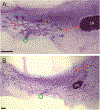Best practices to quantify the impact of reproductive toxicants on development, function, and diseases of the rodent mammary gland
- PMID: 35764275
- PMCID: PMC9491517
- DOI: 10.1016/j.reprotox.2022.06.011
Best practices to quantify the impact of reproductive toxicants on development, function, and diseases of the rodent mammary gland
Abstract
Work from numerous fields of study suggests that exposures to hormonally active chemicals during sensitive windows of development can alter mammary gland development, function, and disease risk. Stronger links between many environmental pollutants and disruptions to breast health continue to be documented in human populations, and there remain concerns that the methods utilized to identify, characterize, and prioritize these chemicals for risk assessment and risk management purposes are insufficient. There are also concerns that effects on the mammary gland have been largely ignored by regulatory agencies. Here, we provide technical guidance that is intended to enhance collection and evaluation of the mammary gland in mice and rats. We review several features of studies that should be controlled to properly evaluate the mammary gland, and then describe methods to appropriately collect the mammary gland from rodents. Furthermore, we discuss methods for preparing whole mounted mammary glands and numerous approaches that are available for the analysis of these samples. Finally, we conclude with several examples where analysis of the mammary gland revealed effects of environmental toxicants at low doses. Our work argues that the rodent mammary gland should be considered in chemical safety, hazard and risk assessments. It also suggests that improved measures of mammary gland outcomes, such as those we present in this review, should be included in the standardized methods evaluated by regulatory agencies such as the test guidelines used for identifying reproductive and developmental toxicants.
Keywords: Developmental abnormality; Differentiation; Ductal hyperplasia; Lactation; Puberty; Terminal end bud.
Copyright © 2022. Published by Elsevier Inc.
Figures






Similar articles
-
Endocrine disrupting chemicals and the mammary gland.Adv Pharmacol. 2021;92:237-277. doi: 10.1016/bs.apha.2021.04.005. Epub 2021 Jul 2. Adv Pharmacol. 2021. PMID: 34452688
-
Toward a digital analysis of environmental impacts on rodent mammary gland density during critical developmental windows.Reprod Toxicol. 2022 Aug;111:184-193. doi: 10.1016/j.reprotox.2022.06.002. Epub 2022 Jun 8. Reprod Toxicol. 2022. PMID: 35690277 Free PMC article.
-
Perinatal ethinyl oestradiol alters mammary gland development in male and female Wistar rats.Int J Androl. 2012 Jun;35(3):385-96. doi: 10.1111/j.1365-2605.2012.01258.x. Epub 2012 Mar 19. Int J Androl. 2012. PMID: 22428746
-
Endocrine-disrupting compounds and mammary gland development: early exposure and later life consequences.Endocrinology. 2006 Jun;147(6 Suppl):S18-24. doi: 10.1210/en.2005-1131. Epub 2006 May 11. Endocrinology. 2006. PMID: 16690811 Review.
-
Environmental exposures and mammary gland development: state of the science, public health implications, and research recommendations.Environ Health Perspect. 2011 Aug;119(8):1053-61. doi: 10.1289/ehp.1002864. Epub 2011 Jun 22. Environ Health Perspect. 2011. PMID: 21697028 Free PMC article. Review.
Cited by
-
Chronic Exposure to Low Levels of Parabens Increases Mammary Cancer Growth and Metastasis in Mice.Endocrinology. 2023 Jan 9;164(3):bqad007. doi: 10.1210/endocr/bqad007. Endocrinology. 2023. PMID: 36683225 Free PMC article.
-
Mammary gland development and EDC-driven cancer susceptibility in mesenchymal ERα-knockout mice.Endocr Relat Cancer. 2023 Nov 14;30(12):e230062. doi: 10.1530/ERC-23-0062. Print 2023 Dec 1. Endocr Relat Cancer. 2023. PMID: 37855322 Free PMC article.
-
Science evolves but outdated testing and static risk management in the US delay protection to human health.Front Toxicol. 2024 Aug 13;6:1444024. doi: 10.3389/ftox.2024.1444024. eCollection 2024. Front Toxicol. 2024. PMID: 39193481 Free PMC article. No abstract available.
References
-
- Russo J and Russo IH, DNA labeling index and structure of the rat mammary gland as determinants of its susceptibility to carcinogenesis. J Nat Cancer Inst, 1978. 61: p. 1451–1459. - PubMed
-
- Russo J and Russo IH, Experimentally induced mammary tumors in rats. Breast Cancer Res Treat, 1996. 39(1): p. 7–20. - PubMed
-
- Fenton SE, Endocrine-disrupting compounds and mammary gland development: early exposure and later life consequences. Endocrinology, 2006. 147(6 Suppl): p. S18–24. - PubMed
Publication types
MeSH terms
Substances
Grants and funding
LinkOut - more resources
Full Text Sources

